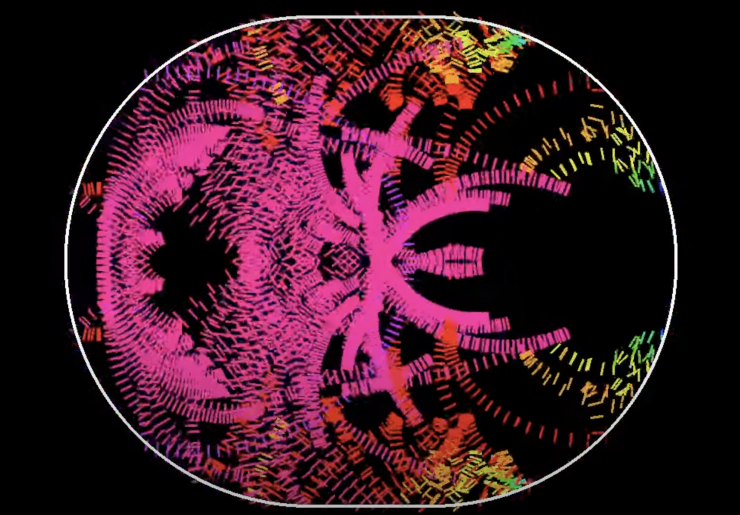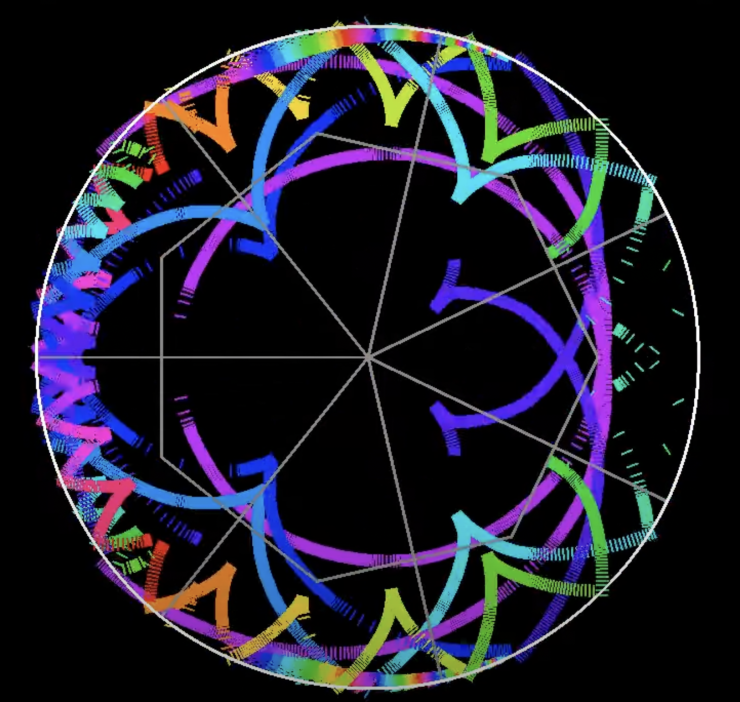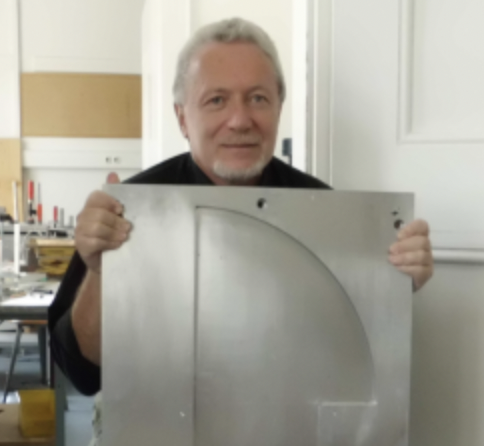Bringing Understanding to Chaotic Dynamics with Billiards, Flowers, and ... Mushrooms?
Feb 10, 2023 — Atlanta, GA

Nils Berglund, a professor of mathematics from the University of Orleans in France, produces videos using Bunimovich methods of visualizing dynamical systems.
Words like billiards, flowers, and stadium get mentioned a lot alongside Leonid Bunimovich’s name. Yet in this context, none of these terms refer to pool tables, botany, or places where World Cup games are played — along with Bunimovich mushrooms, which you (fortunately and hopefully) won’t find on any pizzas or salads.
Instead, these terms refer to the visualization of mathematical concepts — and they’ve made Bunimovich, a Regents’ Professor in the School of Mathematics at Georgia Tech, quite well-known among his peers.
The researcher’s concepts are used by physicists and mathematicians around the world to describe ways to study dynamical systems, Bunimovich’s chief research area. Dynamical systems theory uses mathematical tools to model many components of a phenomena that exists and needs to be explained, and whose state changes over time.
“A current state of the object is described by some characteristics — positions and velocities of particles, for example, or concentrations of some types of viruses,” Bunimovich explains. Their evolution can be regular — fixed and relatively easy to predict, or complex (chaotic = quasi-random) and not so easy to predict, or both.
Dynamical systems can model changes over time of numbers in data, bringing some clarity to economic theories. They can model phenomena in health and medicine, weather patterns, planetary bodies, and quantum mechanics; any complex system with lots of moving parts that needs to be observed, understood, and predicted.
Knowing how those particles bounce off walls of a Bunimovich stadium, and each other, and their trajectories, can help mathematicians and physicists provide better predictability to those movements.
Bunimovich is modest about his fame in the field. “Mostly the billiards give people a vision of chaotic dynamics. All these Bunimovich stadiums, mushrooms, flowers, provide such visual examples which demonstrate that some unimaginable before types of evolutions (changes) may occur, and how it happens.” He says an old saying proves his point: it is better to see just once than hear a hundred times.
Figuring out those patterns helped researchers develop chaos theory, “one of the major discoveries of the 20th century,” Bunimovich explains. Chaos theory examines random or unpredictable behaviors in dynamical systems run by fixed deterministic rules, and it is applied to a range of scientific and mathematical disciplines.
Updating math concepts for the 21th century
Bunimovich notes that he wasn’t the first to use the concept of billiards to study dynamical systems. Y.G. Sinai, Bunimovich’s former adviser currently at Princeton University, wrote a 1970 paper introducing the concept of dynamical billiards, where a point particle bounces around inside a rectangular shape with a removed circle as in a billiards game, but without losing its speed.
Sinai was himself a student of A.N. Kolmogorov, one of the greatest Russian mathematicians who conducted pioneering research in probability, theory of functions, turbulence theory, and complexity theory. It was Kolmogorov “who particularly built a bridge between random and deterministic worlds, and random and deterministic systems,” Bunimovich said.
Dan Margalit, a fellow professor in the School of Mathematics at Georgia Tech, adds that Bunimovich is credited with taking these concepts introduced by other Russian mathematicians and updating them for 21th century uses in probability and quantum theory, as well as physics. “The basic idea is that you have a billiard table of a certain shape, and you want to know if I shoot a frictionless billiard ball in some direction, will it eventually travel over the whole table,” Margalit said.
Another way to visualize dynamical systems is through Bunimovich mushroom billiards, which get their name from their caps-and-stems shapes that form in visualizations that depict particle movements. “It is a general belief, although not proved, that typical dynamical systems have regions with regular motion/dynamics, or stable islands, situated in chaotic seas where dynamics is chaotic,” he said. “Mushrooms are the only large class of billiards where such coexistence was proved. Moreover, they are very visual and easy to build, which has been done in various physics labs.”
The origins of a Bunimovich stadium and Bunimovich elliptical flowers
The trajectories of any particle resembling a billiard ball also play a part in Bunimovich’s development of a stadium, which he introduced in a 1974 paper. The American Mathematical Society defines a Bunimovich stadium as “a rectangle capped by semicircles in which a particle moves at constant speed along straight lines, reflecting off the boundary in a way that the angle of incidence equals the angle of reflection.”
Bunimovich’s stadium showed that generally, chaotic dynamics was much more common for all dynamical systems than previously thought. “It is just a more deep understanding of chaos, and a stadium allows for rigorous mathematical proof of discovery which physicists did not believe until they made experiments and saw it.”
A recent Bunimovich discovery: elliptical flower billiards, which may help with experimental studies in physics labs as well as mathematical ones, according to the abstract of Bunimovich’s 2021 paper on the subject. Elliptical flower billiards take into account other factors that may impact the trajectories of the billiards.
“Elliptic flowers are the only ones where the coexistence of chaotic and non-chaotic regions is rigorously proved, and non-chaotic regions do not have a very specific shape like in mushroom billiards,” Bunimovich said. These changes of shape can help researchers make better sense of classical systems, whose variables are strictly defined and can be precisely measured, and quantum systems, where the action happens at the atomic or subatomic level.
‘Mathematics and physics can be beautiful’
Nils Berglund, a professor of mathematics at the University of Orleans in France, has produced YouTube videos showing Bunimovich elliptical flowers billiards, which he calls “examples of systems that can be proved to have mixed dynamics, with both regular and chaotic trajectories.” The resulting animations are colorful representations of Bunimovich’s innovations and those of other mathematicians.
“With these animations, I am trying to show that mathematics and physics can be beautiful,” Berglund shares on his channel. “They are all based on real models in physics and math, typically describing the evolution in time of some system: a particle or a wave in a closed domain, a growing interface, a population of animals.”
Bunimovich’s elliptical flower discovery isn’t quite two years old, so he doesn’t expect that a lot of physicists know about it yet. “But I fully expect they will build elliptical flowers in physics labs, as it was with the stadium and mushrooms.”
Bunimovich’s unique creations offer others like Berglund a chance to inject some 21th century creativity into math and physics problems. But to Bunimovich, it’s all in line with traditional scientific processes, beginning with observations.
“All science is a collection of studies that started with just observations of evolution in time of various objects — for example, the motion of planets and the sun. A general, and basically true opinion is that mathematicians prove only the things which physicists did already know or which did not have any physical or scientific meaning. But there are exceptions when mathematicians discover some phenomena which physicists never imagined to exist.”
These studies of purely deterministic dynamical systems provide some foundation for theories, but they still involve probabilities; a mix of the known and the unknown.
“This topic is at the border of philosophy,” Bunimovich said.



Writer: Renay San Miguel
Communications Officer II/Science Writer
College of Sciences
404-894-5209




